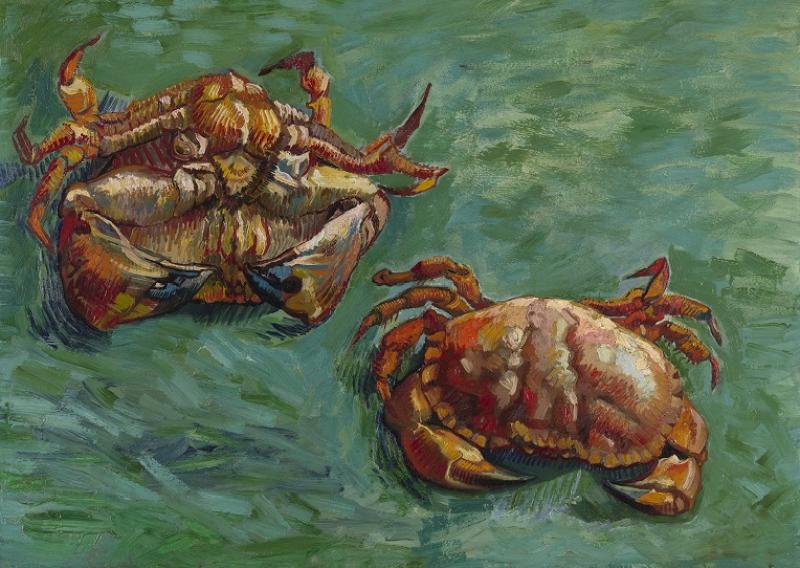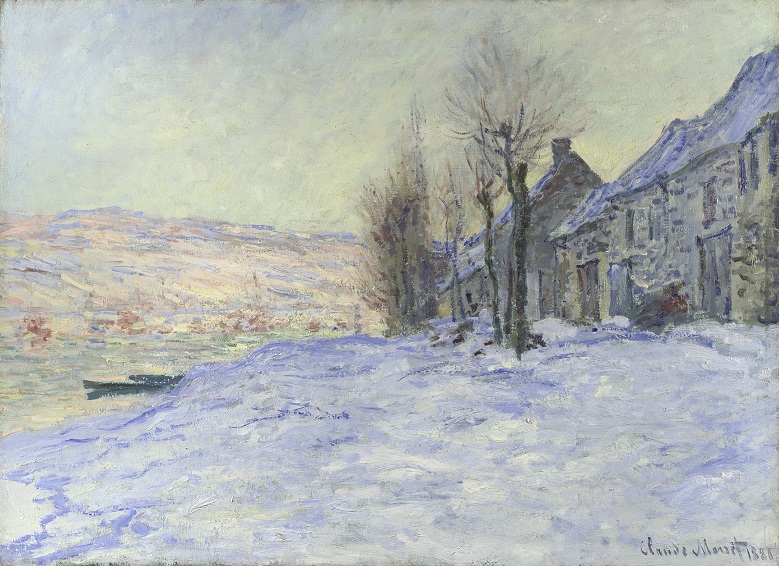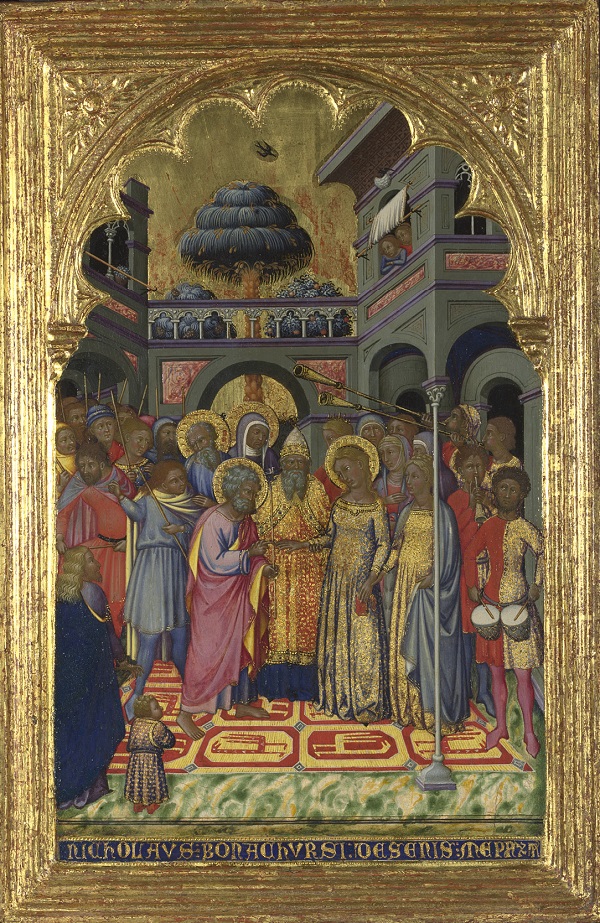Making Colour, National Gallery | reviews, news & interviews
Making Colour, National Gallery
Making Colour, National Gallery
An exploration of colour brings art and science together, but it's an uneasy relationship

The National Gallery has a range of personas it adopts for its exhibitions, and for this one, about colour, it has deployed the po-faced, teachy one. The pompous tone is because it’s not just about art this time, there’s science in it, which makes it extra serious.
This is a subject I find very, very interesting, and I think it is fair to say that many of the curiosities that arise from looking at early Renaissance paintings, in particular, are to do with colour. The cheerfully exotic blue trees in Niccolò di Buonaccorso’s The Marriage of the Virgin (pictured below left), about 1380, are entirely the result of an unwise choice of pigment. Mixed from a durable blue pigment and a much less light-stable yellow pigment, what must once have been a good strong green has lost all traces of yellow, leaving only a slightly comical, vivid blue.
 Light sensitive pigments, red ones this time, are the cause of the unhealthy green flesh tones so characteristic of many Renaissance panel paintings. In David Ghirlandaio’s The Virgin and Child with Saint John, probably about 1490-1500, the pink flesh tones have faded so that we can see through to the layer of green earth beneath; put there to balance skin tones and make them more naturalistic, the green was never meant to be visible. And in more modern times, the wonderful icy blue that runs through Monet’s Lavacourt Under Snow (pictured above right), about 1878-81, can be seen as a celebration of cobalt blue, just one of the synthetic blues that revolutionised painting in the 19th century by making available a range of affordable, reliable colours.
Light sensitive pigments, red ones this time, are the cause of the unhealthy green flesh tones so characteristic of many Renaissance panel paintings. In David Ghirlandaio’s The Virgin and Child with Saint John, probably about 1490-1500, the pink flesh tones have faded so that we can see through to the layer of green earth beneath; put there to balance skin tones and make them more naturalistic, the green was never meant to be visible. And in more modern times, the wonderful icy blue that runs through Monet’s Lavacourt Under Snow (pictured above right), about 1878-81, can be seen as a celebration of cobalt blue, just one of the synthetic blues that revolutionised painting in the 19th century by making available a range of affordable, reliable colours.
I suspect that the exhibition has been organised colour by colour, rather than by date, or geography, because to do so looks technical and dispassionate, in keeping with the exhibition’s decidedly scientific bent. But the approach is riddled with problems, the greatest being that all colours are not equal. Some, like blue and green, really can yield insights into why and how paintings look as they do, but once you get onto yellow and purple, there is only a limited amount to be said.
And so it is that Gainsborough’s The Painter’s Daughters Chasing a Butterfly, about 1756, is put in a room with some other very yellow paintings in order to point out that one of the dresses is painted with lead tin yellow. Queasy headache aside, it is a curatorial strategy that leaves you unable to make any sense of what is on the walls unless you read all the labels, a sure sign that things have gone belly-up.
 If you were hoping to be blinded with science, only disappointment awaits. Aside from some photographs showing cross sections of paint layers and occasional little pots of pigment, the science is often elusive and always unsatisfactory. Where it exists, it is descriptive rather than explanatory, and betrays the uneasy relationship between science and art and an uncertainty about how to communicate scientific ideas to the public. A section on colour theory presents an array of paintings that exploit the effects of juxtaposing certain colours, with Van Gogh’s Two Crabs, 1889, (main picture) and Carlo Crivelli’s Saints Peter and Paul, probably 1470s, a fine sight in a room devoted to the stunning results achieved by using combinations of complementary and primary colours.
If you were hoping to be blinded with science, only disappointment awaits. Aside from some photographs showing cross sections of paint layers and occasional little pots of pigment, the science is often elusive and always unsatisfactory. Where it exists, it is descriptive rather than explanatory, and betrays the uneasy relationship between science and art and an uncertainty about how to communicate scientific ideas to the public. A section on colour theory presents an array of paintings that exploit the effects of juxtaposing certain colours, with Van Gogh’s Two Crabs, 1889, (main picture) and Carlo Crivelli’s Saints Peter and Paul, probably 1470s, a fine sight in a room devoted to the stunning results achieved by using combinations of complementary and primary colours.
But should the National Gallery, custodian of one of the world’s great art collections, be quite so surprised that artists knew about these special colour relationships long before scientists formalised them? The curators seem unaccountably amazed that Crivelli’s "sense of colour is intuitive", while Annibale Carracci, who made deliberate use of primary colours despite almost certainly not having read up on colour theory, is treated with the same slack-jawed awe.
It is a worrying disclosure, because it suggests that at the National Gallery, in common with wider society, there is a tendency to elevate science over art, indiscriminately treating science, whether good or bad, with credulous acceptance. Just as cosmetics manufacturers know that a lab coat can shift face cream, this exhibition, which claims to "bring together the worlds of art and science" tries to add value by claiming a scientific basis, while simultaneously backing away from taxing its audience with any genuine insights. The tendency to crave validation by science is an insidious one, that undermines the value that good science can offer while pointing to a fundamental lack of confidence in art itself from the very institution that should be its champion.
Explore topics
Share this article
The future of Arts Journalism
You can stop theartsdesk.com closing!
We urgently need financing to survive. Our fundraising drive has thus far raised £49,000 but we need to reach £100,000 or we will be forced to close. Please contribute here: https://gofund.me/c3f6033d
And if you can forward this information to anyone who might assist, we’d be grateful.

Subscribe to theartsdesk.com
Thank you for continuing to read our work on theartsdesk.com. For unlimited access to every article in its entirety, including our archive of more than 15,000 pieces, we're asking for £5 per month or £40 per year. We feel it's a very good deal, and hope you do too.
To take a subscription now simply click here.
And if you're looking for that extra gift for a friend or family member, why not treat them to a theartsdesk.com gift subscription?
more Visual arts
 'We are bowled over!' Thank you for your messages of love and support
Much-appreciated words of commendation from readers and the cultural community
'We are bowled over!' Thank you for your messages of love and support
Much-appreciated words of commendation from readers and the cultural community
 Folkestone Triennial 2025 - landscape, seascape, art lovers' escape
Locally rooted festival brings home many but not all global concerns
Folkestone Triennial 2025 - landscape, seascape, art lovers' escape
Locally rooted festival brings home many but not all global concerns
 Sir Brian Clarke (1953-2025) - a personal tribute
Remembering an artist with a gift for the transcendent
Sir Brian Clarke (1953-2025) - a personal tribute
Remembering an artist with a gift for the transcendent
 Emily Kam Kngwarray, Tate Modern review - glimpses of another world
Pictures that are an affirmation of belonging
Emily Kam Kngwarray, Tate Modern review - glimpses of another world
Pictures that are an affirmation of belonging
 Kiefer / Van Gogh, Royal Academy review - a pairing of opposites
Small scale intensity meets large scale melodrama
Kiefer / Van Gogh, Royal Academy review - a pairing of opposites
Small scale intensity meets large scale melodrama
 Jenny Saville: The Anatomy of Painting, National Portrait Gallery review - a protégé losing her way
A brilliant painter in search of a worthwhile subject
Jenny Saville: The Anatomy of Painting, National Portrait Gallery review - a protégé losing her way
A brilliant painter in search of a worthwhile subject
 Abstract Erotic, Courtauld Gallery review - sculpture that is sensuous, funny and subversive
Testing the boundaries of good taste, and winning
Abstract Erotic, Courtauld Gallery review - sculpture that is sensuous, funny and subversive
Testing the boundaries of good taste, and winning
 Edward Burra, Tate Britain review - watercolour made mainstream
Social satire with a nasty bite
Edward Burra, Tate Britain review - watercolour made mainstream
Social satire with a nasty bite
 Ithell Colquhoun, Tate Britain review - revelations of a weird and wonderful world
Emanations from the unconscious
Ithell Colquhoun, Tate Britain review - revelations of a weird and wonderful world
Emanations from the unconscious
 Rachel Jones: Gated Canyons, Dulwich Picture Gallery review - teeth with a real bite
Mouths have never looked so good
Rachel Jones: Gated Canyons, Dulwich Picture Gallery review - teeth with a real bite
Mouths have never looked so good
 Yoshitomo Nara, Hayward Gallery review - sickeningly cute kids
How to make millions out of kitsch
Yoshitomo Nara, Hayward Gallery review - sickeningly cute kids
How to make millions out of kitsch
 Hamad Butt: Apprehensions, Whitechapel Gallery review - cool, calm and potentially lethal
The YBA who didn’t have time to become a household name
Hamad Butt: Apprehensions, Whitechapel Gallery review - cool, calm and potentially lethal
The YBA who didn’t have time to become a household name

Add comment